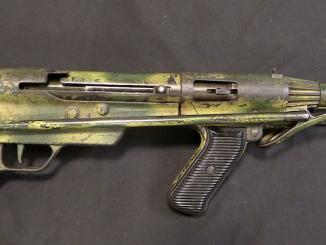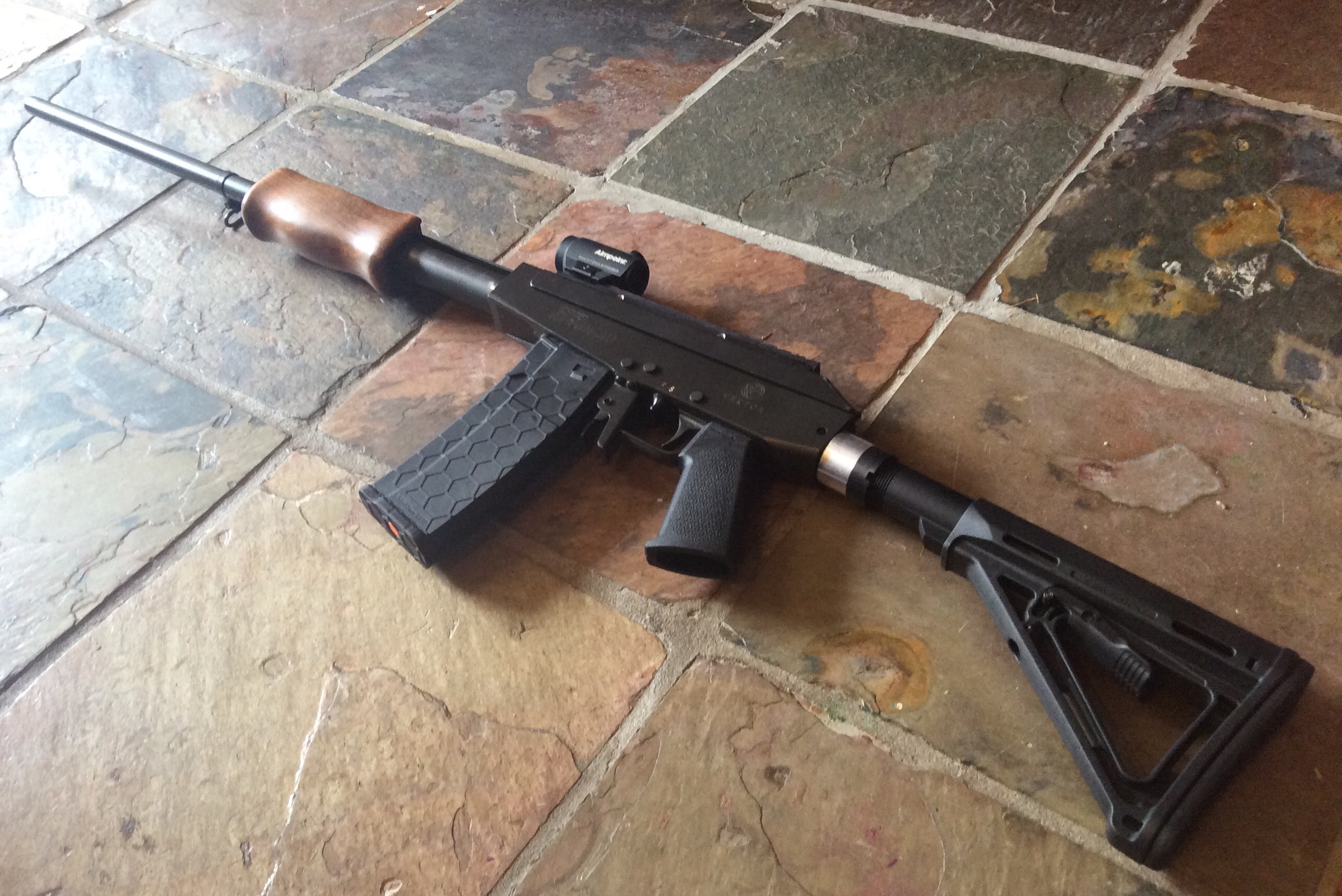https://youtu.be/r00oJ84t3AQ
I had the chance to take a look at this Australian World War 2 Owen submachine gun, and it’s *very* bright camouflage paint. My initial reaction was that it was a poorly done restoration, because of just how neon-Mountain-Dew-green it was. However, as it turns out, the stock on this example came out of a sealed package as new old stock from an Australian parts warehouse. That bright paint is in fact original, having not been subjected to sunlight since it was painted at the factory in the 1940s. Remarkable!




It would be interesting to see this Camo in a jungle background. It might actually work. There is some really different colors in nature.
Keep up the great work Eon, I look forward to your video’s every day.
Similar principle to dazzle camo on warships, perhaps?
Dazzle camo was primarily intended to break rangefinders, not to hide the ships.
No. The principle of dazzle painting was that since you couldn’t hide a ship you could deceive a submarine Captain as to angle, speed or direction as he was trying to aim a torpedo.
And in any case, that doesn’t look anything like dazzle camo.
Splattered sunlight.
Years ago I acquired a new Ugandan camo jacket which had a similar striking clash of color. The base fabric is a rather bright shade of light green with two overprinted colors, green & brown, both so dark as to be hard to differentiate. Later I found color photos of the item in the field. All three colors had faded to the point where they worked well as camouflage. My theory with no data to back it up is that this was deliberately done by the manufacture with an eye to the equatorial suns bleaching effect. Perhaps this is the case for the Aussie camo paint.
That paint is so bright, I saw my own skull.
Lemon orchard camo !
Exclusive to Aussie troops !
(beside joking, is there a specific reason for this choice? Trocpical colors?)
thinking of some artwork from one of my old jobs.
This bright yellow was used to mimic sunlight breaking through the forest canopy on the forest floor.
In that light(pun intended)it actually makes a lot of sense and seems accurate
All we need to go with this is Ian or Karl disguised as a bush!
I am willing to bet they each own a ghillie suit – close enough
Manufacturer – The paint is a bit off, so we’ll knock the price down
Army – Sold !
Or a clown suit.
Ian, you need to study a few more Owen guns with original finish.
To imagine that any Owen gun left the Lysaght Works painted a fluorescent green resembling Kermit the Frog strains my credulity even beyond my post-6 P.M. gullibility after a glass of wine.
There are photos extant of the women painting those guns at the factory with spray guns and no neat stencils. It was all very irregular, splotchy and haphazard and the color black was always included. There were no neat tiger-stripes; the green used was dark, almost olive. The whole idea was to blend with jungle under triple canopy. Day-Glo Green would have called attention to the gun, not camouflaged it, and the troops could not afford to wait for the elements to fade it. It’s doubtful if such Day-Glo green paint was even available in Australia during the hard-pressed war years. Moreover, the magazines were just painted dark flat green, not originally camo.
There were at least four patterns of buttstocks for Owen guns during the war.. maybe more. The one shown is of the late pattern (probably with a butt trap), and may have been a postwar spare part or a original salvaged, refurbished and repainted (by somebody) –in which case it would bear a serial number. But it’s a long leap to conclude that this represents the color scheme of guns that left the factory during the war.
The Austen gun is not really comparable as it was made (and painted) in a different factory.
M
I remember seeing a very bright one at the AWM Canberra, couldn’t find an image of it, but this one – https://www.awm.gov.au/collection/RELAWM30622.010 doesn’t look like is had any black sprayed on it.
Warwicks used to have stock of, well stocks, and I remember them being quite bright too.
You say “It’s doubtful if such Day-Glo green paint was even available in Australia during the hard-pressed war years”, yet Ian says that the color here is factory fresh.
If you think colour of the Owen is garish then you should have seen some of the combat jackets. My old man had lime green one that virtually glowed in the dark. He wore it in Ireland in the seventies and it blended right in with the colour of that landscape too. I think the range of tropical colours, particularly in high rainfall tropical forrest would completely justify those shades.
Camouflage is one of those things that a lot of people just don’t “get”. They think that the usual run of commercial patterns are the only things that work, while the fact is that there are a lot of counterintuitive camouflage solutions that work, and look nothing like what is “traditional”. Dazzle camouflage is one example of that.
I remember doing a camouflage/target acquisition exercise during the fall, one year. This was in Germany, back during the mid-eighties; US Army woodland pattern was the order of the day, with West German OD green. Interestingly, spotting both of those against the fall foliage was child’s play. The one we had the most problems with? Some German civilians in garish civilian hiking gear that blended into the fall colors like you wouldn’t believe.
Friend of mine did some considerable time in Panama, running the Jungle School Engineer element. His preferred mode of dress, for concealment? Hawaiian shirts and cargo shorts. Against the jungle backdrop, those blended in while clean woodland camouflage stood out because the shades of green used were atypical. Of course, once they got dirty, they all worked pretty well.
And, I do have to admit, the Hawaiian shirt thing is real. I’ve seen it myself–Some of the most garish colored ones just blend right into the background in the right environment, and there’s exactly zero congruency with what most people would think of as “dressing for concealment”. It’s all about the pattern and the backdrop, not necessarily the colors.
At least, for the human eye. There are colors and such that would stand out like sore thumbs for a lot of other animals, particularly ones that can see into different parts of the spectrum.
I found that the Hawaiian shirt thing did work very well in Hawaii. It surprised me that the late Seventies “cammies” issued to Marines didn’t work as well–but then I was used to seeing my brother Marines in either utilities or cammies. Picking out the familiar is much easier than identifying strange stuff.
Woodland wasn’t designed to hide people or equipment. It was intended for pattern disruption: “We can see there’s something there, we just can’t see quite what it is or how many there are.”
While driving the Fall foliage back roads (upstate NY)I had to make a pit stop. I was wearing a Swiss Smock. My wife could not find me after 4 steps into the bushes.
I presume you’re talking the garishly-colored version they called Alpenflage?
I’ve seen that stuff in use, and I’ll tell you this much: It looks like something you’d put on a clown while in garrison, but out in the actual Alps? It works.
Zombie green?
Remember the american propaganda machine presented those (dam) japs as inferior physical specimens with bad eyesight so obliously with their thick bottle glass thick eye glasses (sgt. rock) they were fooled by the Owen guns camoflage
Right, and the same propaganda claimed that Japanese people were nothing more than mutant yellow monkeys to be hunted and stuffed on your wall. You can guess this insult didn’t make the situation much better for the American survivors of Bataan when the Japanese Army captured such propaganda papers.
Yeah, it blended right in with their own anti-Western propaganda. All the sides did it, and there weren’t any innocents when it came to institutionalized dehumanization of the enemy. The real difference is that the stuff you see from the US side was preserved, and is accessible to the average reader. The Japanese equivalent propaganda didn’t survive, got destroyed after the war, and is almost totally inaccessible to anyone not Japanese and familiar with the pre-WWII writing systems.
There’s a couple of different reasonably good-quality historical works that highlight this ugly fact of history. The US did it, but it wasn’t exactly unique or the only side that rendered the other side as subhuman.
All y’all need to spend some time in Asia on the ground. You think Americans are racist? LOL… Let me introduce you to just about any Asian nationality, particularly the Chinese, Koreans, and Japanese. Vietnamese aren’t quite as bad, having been victimized by everyone else for centuries. The other groups? Assholes, in general, and entirely unrepentant.
“(…)nothing more than mutant yellow monkeys to be hunted and stuffed on your wall(…)”
Wait, but what about Australian one? My cursory search do not revealed such posters. Possibly best known HE’S COMING SOUTH does not “mutant yellow monkey” trait.
https://yearnineworldwartwo.weebly.com/why-did-australians-enlist-in-wwii.html
“(…)japs as inferior physical specimens with bad eyesight so obliously with their thick bottle glass thick eye glasses(…)”
This sound like from You’re a Sap, Mr. Jap https://popeye.fandom.com/wiki/You%27re_a_Sap,_Mr._Jap
Over time, colours can change without being subjected to sunlight. We cannot be sure about this being the original colour pattern.
I carried an Owen Gun a fair few times in the late 60s and 70s. Two of them were painted and one looked just like that.
Despite being a lot heavier than the Regs F1 SMG it was more accurate and fired a whole lot faster. Vietnam vets who had used both preferred the Owen gun.
Here is the most camouflage pattern. 😉
https://www.xmple.com/wallpaper/orange-black-stripes-lines-streaks-1920×1080-c2-000000-ffa500-l2-192-192-a-60-f-1.svg
Alpenflage (Tarnzug 1957) is a descendent of the SS-Leibermuster with a more reddish hue. I have seen 1950s Czech Smocks of a similar pattern and the 1955 Belgian produced model (for the Bundeswehr) often mistaken for Alpenflage. With a little fade Alpenflage is quite suitable….
Well that camo aint wrong. The brightness of the contrast of colors really helps destroy line seeking for the eye.
Ian, what happened to this video?